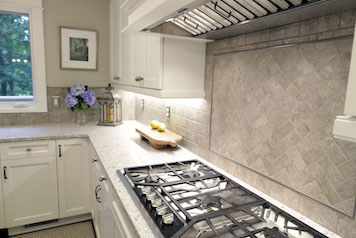
It is crucial to grout between tiles to prevent moisture, temperature and other changes from causing damage. Grout also absorbs tensile force and can be used as a solution for structural instability. It can protect the tiles from humidity changes and prevent cement from retracting depending on the material. This article will teach you how to grout tile. These tips do not replace professional advice. Proper grouting is dependent on the material conditions and preparation.
The grout float is a flat rubber cushion that can be used to smoothen grout. The grout float must be cleaned every three hours to ensure it does not get damaged. It should always be close to a bucket of hot water to rinse or change it. It should be cleaned as often as possible. You must clean the tiles as well if you're cleaning them yourself.

For stubborn areas, a combination of a gallon of hot water and a cup of granulated sugar can be used to remove the grout. This mixture can remove excess grout, but it can also damage tiles. Before applying grout cleaners, make sure to thoroughly clean the tiles. If you are unsure which product to choose, you can use water and a scratch pad.
To clean grout effectively, you must make sure that you use neutral or alkaline cleaners to remove stubborn stains. Microfiber towels are more porous than regular towels and can be used to remove grout haze. Microfiber towels make it much easier to remove the grout-haze. Make sure you test any cleaner first on an inconspicuous location before applying it to your grout. Use a microfiber towel to ensure that grout isn't damaged.
Next, use a sponge. Use a sponge sparingly as it can cause uneven grout lines. Use your index finger to hold the sponge and drag it along the tile until you achieve a smooth grout joint. To determine the best technique for you, you can start with a small portion of tile and grout the whole area. In this way, you can ensure that all the grout joints are the same height.

Next, prepare the grouting area. Grout floats may also be available. This tool looks similar to a trowel. However, it's designed to press grout between tiles. This tool takes the grout mixture out and spreads it diagonally onto the tile surface. Make sure that the grout float is held at a 45 degree angle to the tile surface and not digging into the joints. A grout float can be used to smoothen out grout imperfections.
FAQ
Is it possible to live in a house that is being renovated?
Yes, I can live in a house while renovating it
Can you live in a house and have renovations ongoing? The duration of the construction works will affect the answer. If the renovation process lasts less than 2 months, then yes, you can live in your home while it's under construction. If the renovation takes longer than two weeks, however, you can't live in your home during the construction.
There are many reasons why you should not live at home during major construction projects. You might be hurt or even die from falling objects on the site. There is also the possibility of dust and noise pollution from the heavy machinery at the job site.
This is especially true when you live in a multistory house. In such cases, vibrations and noises from construction workers may cause irreparable damage to your property.
As mentioned earlier, you will also have to deal with the inconvenience of living in a temporary shelter while your home is being renovated. This means you won’t have the same amenities as your own home.
As an example, your washer and dryer will be out of commission while they are being repaired. Additionally, the smell of paint fumes or other chemicals will be a constant annoyance as well as the banging sound made by workers.
All these things can lead to anxiety and stress in your family. You should plan ahead to avoid feeling overwhelmed by this situation.
When you decide to start renovating your home, it is best to do some research first so that you can avoid making costly mistakes along the way.
You can also consider professional advice from a trusted contractor to ensure smooth running of your project.
Can I renovate my whole home myself?
If you can do it yourself, why pay someone else when you could save money and time?
It doesn’t matter how much DIY is your passion, sometimes it can be difficult to do the job yourself. You might not be able control many of the variables.
If you have an older home, for example, the wiring might be outdated. To ensure safety and reliability, you will need to hire an electrician.
It is possible that your renovations might cause structural damage.
Additionally, you may not have the right tools to complete the job. For instance, if you are planning to install a new kitchen sink, you'll need to buy a special tool called a plumber's snake which is used to clear clogged pipes.
You must also follow plumbing codes to ensure that a licensed plumber is working on your project.
Let's just say that you must know what you can do before you undertake such a daunting task.
Ask your friends and family for help if you're unsure if the job is possible.
They can help you determine the right steps and where you can find out more.
Which order should you do your home renovations?
First, decide where you want everything to go in your renovations. If you intend to sell your home in the near future, you need to think about how you will present it to potential buyers. Next, think about how you want your living space, including the kitchen, bathroom and living room. Once you have chosen the rooms you want to remodel, you can start looking for contractors who can help you. After you have hired a contractor to work on your project, it is time to get started.
How do you renovate a house with no money?
If you are looking to renovate a house with no money, here are some steps:
-
Create a budget plan
-
Find out what materials you need
-
Decide where you want to put them
-
Make a list with the items you need to purchase
-
How much money do you have?
-
Plan your renovation project
-
Start to work on your plans
-
Do some online research
-
Ask friends and family for help
-
Get creative
Statistics
- On jumbo loans of more than $636,150, you'll be able to borrow up to 80% of the home's completed value. (kiplinger.com)
- Most lenders will lend you up to 75% or 80% of the appraised value of your home, but some will go higher. (kiplinger.com)
- It is advisable, however, to have a contingency of 10–20 per cent to allow for the unexpected expenses that can arise when renovating older homes. (realhomes.com)
- A final payment of, say, 5% to 10% will be due when the space is livable and usable (your contract probably will say "substantial completion"). (kiplinger.com)
- ‘The potential added value of a loft conversion, which could create an extra bedroom and ensuite, could be as much as 20 per cent and 15 per cent for a garage conversion.' (realhomes.com)
External Links
How To
How do I plan a whole house remodel?
Planning a whole-house remodel requires planning and research. Before you start your project, there are many factors to consider. It is important to determine what type of home improvements you are looking to make. There are many options available, including kitchen, bathroom and bedroom. After you decide which category you want to work on, figure out how much you can afford to spend on the project. If you do not have any previous experience in working with homes, it is best that you budget at least $5,000 per bedroom. If you have experience, you may be able to manage with less.
Once you've determined the amount of money you can spend, you need to decide how large a job you want. If you have only enough money to remodel a small kitchen, you may not be able add new flooring, countertops, or paint the walls. On the other side, if your budget allows for a full renovation of your kitchen, you'll be able do just about any task.
The next step is to find a contractor who specializes in the type of project you want to take on. You'll get high-quality results and save yourself lots of headaches down the line. Once you have found a reliable contractor, it is time to start gathering supplies and materials. You might need to make everything from scratch depending upon the size of your project. However, there are plenty of stores that sell pre-made items so you shouldn't have too much trouble finding everything you need.
Once you have all of the necessary supplies, you can start making plans. First, you'll want to draw up a rough sketch of where you want to place furniture and appliances. Then you will design the layout. Remember to leave enough space for outlets and plumbing. It is a good idea to place the most important areas nearest the front door. This will make it easier for visitors to access them. Last, choose the colors and finishes that you want to finish your design. To save money and keep your budget low, you should stick to neutral tones.
Now that your plan is complete, it's time you start building! Before you start any construction, be sure to check the local codes. Some cities require permits. Other cities allow homeowners without permits. You will need to first remove all walls and floors that are not required for construction. You will then lay plywood sheets to protect your new flooring. Next, nail or screw pieces of wood together to form the frame that will house your cabinets. You will attach doors or windows to the frame.
There will be some finishing touches after you are done. Covering exposed pipes and wires is one example. This can be done with plastic sheeting and tape. It's also a good idea to hang mirrors and photos. Make sure to keep your work area neat and tidy.
These steps will ensure that you have a beautiful and functional home, which will save you tons of money. You now have the knowledge to plan a complete house remodel.